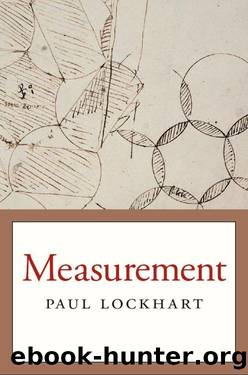Measurement by Paul Lockhart

Author:Paul Lockhart [Lockhart, Paul]
Language: eng
Format: epub
Publisher: Harvard University Press
Published: 2012-09-24T21:00:00+00:00
The modern way to think about dimension is as an invariantâone of the sturdiest invariants there is, in fact. A space can be subjected to the most drastic deformations and distortions, and its dimension will not change. The surface of a sphere is two dimensional, and no matter how you stretch it, dent it, or twist it, it will remain two dimensional.
The main use of dimension in mathematics is as a classification tool. Most people enjoy sorting things into groups, and geometers are no different. Just as biologists like to divide living things into various categories (plants, animals, fungi, etc.), geometers are also faced with a rich and varied multitude of shapes and the desire to classify them into groups is irresistible.
The most important feature of living things is that they are alive. They convert energy, and distinctions can be made based on the manner in which this is done (e.g., photosynthesis, respiration, fermentation). This is what makes animals different from plants, for instance.
To me, the most important thing about a geometric object is that it can be measured. It makes sense to divide shapes into categories depending on the manner in which this is done. Curves are different from surfaces because length is different from area.
In a way, this is a subtle point. When we talk about measuring the circumference and area of a circle, we are actually talking about two completely different objects. The circumference is a length measurement of the curve known as a circle. The area measurement is referring to the surface consisting of the interior of the circle, usually called a disk. Similarly, geometers use the word sphere to mean the two-dimensional surface, whereas the solid object is referred to as a ball. So we measure the length of a circle, the area of a disk or sphere, and the volume of a ball.
Thus, one-dimensional spaces (also known as curves) correspond to one-dimensional measurement, namely length. Two-dimensional spaces (surfaces) are measured in terms of area; and solids occupy volume.
What is the volume of a four-dimensional box? How long is its diagonal?
Show that a four-dimensional pyramid occupies one-quarter of its four-dimensional box.
What is the four-dimensional analog of a cone? Can you measure its volume? How about a sphere?
Dimension plays the same role in geometry as kingdom does in biology: it is the top-level hierarchical subdivision. As different as the surface of a cone is from that of a cube, they are closer to each other than either is to a straight line or the space inside a ball.
Here is another nice way to think about dimension. Suppose we have some shapes of various dimensions, and we scale them by a certain factor r. The natural size measurements are then affected in different ways depending on the dimension of the shape. The lengths of curves get multiplied by the scaling factor r, the areas of surfaces by r2, and the volumes of solids by r3. So the dimension appears as the power of the scaling factor.
What is
Download
This site does not store any files on its server. We only index and link to content provided by other sites. Please contact the content providers to delete copyright contents if any and email us, we'll remove relevant links or contents immediately.
Metric Handbook by Buxton Pamela;(341)
Measurement by Paul Lockhart(223)
Simulating Weather Experiments for Kids - Science Book of Experiments | Children's Science Education books by Baby Professor(161)
Springer Handbook of Metrology and Testing by Horst Czichos Tetsuya Saito & Leslie Smith(152)
The Five Most Important Science Experiments...Ever!!: From Einstein to Newton: An Overview of Five Groundbreaking Physics and Chemistry Experiments in ... Theory, Relativity, Light Speed and More! by Tim Rifkind(152)
Light and Specular Microscopy of the Cornea by Katerina Jirsova(114)
